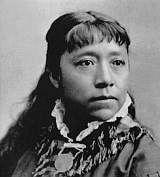Fort McDermitt Paiute and Shoshone Tribe facts for kids

Sarah Winnemucca, a Northern Paiute activist and author, worked as an interpreter, scout and hospital matron at Fort McDermit from 1868 to 1873.
|
|
| Total population | |
|---|---|
| 689 enrolled members (1992) 341 residents on reservation (2010) |
|
| Regions with significant populations | |
( |
|
| Languages | |
| Northern Paiute language, English | |
| Religion | |
| Christianity, Sun Dance, Native American Church, Traditional Unity Movement | |
| Related ethnic groups | |
| Southern Paiute and Western Shoshone peoples |
The Fort McDermitt Paiute and Shoshone Tribe is a federally recognized tribe made up of Northern Paiute and Western Shoshone peoples. Their home, the Fort McDermitt Paiute and Shoshone Tribes of the Fort McDermitt Indian Reservation, is located right on the border between Nevada and Oregon, close to Idaho.
People from these two tribes have also lived in what is now southwestern Idaho for a long time. They share many cultural traditions and language similarities with the Bannock people and other groups who speak Shoshone languages. Members of these tribes are also part of other federally recognized tribes in Nevada and Idaho.
In October 2016, a special federal law was passed. This law added about 19,094 acres of land from the Bureau of Land Management (BLM) to the Tribe's reservation. This was done to help the Tribe grow and have more land. This law is called the Nevada Native Nations Land Act. It's important to know that Gambling is not allowed on these new lands.
Contents
The Fort McDermitt Reservation
The Fort McDermitt Indian Reservation stretches across the border between Nevada and Oregon. It is located in Humboldt County, Nevada and Malheur County, Oregon. The Quinn River flows through the Tribe's land in Nevada, running from east to west. Southwestern Idaho is just to the east.
The Fort McDermitt Military Reservation was first set up on August 14, 1865. It was built where an old stagecoach stop, Quinn River Station, used to be. This area was a traditional seasonal home for the Paiute, Shoshone, and Bannock peoples.
The reservation was created with about 16,354 acres in Nevada and 19,000 acres in Oregon. Most of this land is dry. In October 2016, the government added about 19,094 acres of land to the reservation. This was done to help the tribe have a more stable and larger home. This new land also does not allow gaming. This land transfer happened because of the Nevada Native Nations Land Act.
History of the Area
The fort was originally built to protect the stagecoach route. This route went from Virginia City through Winnemucca, Nevada to Silver City, in what was then the Idaho Territory. The fort was named after Lt. Col. Charles McDermit. He was a military commander who died in a fight in the area in 1865.
The Paiute people traditionally lived in a wide area, from the Southwest up into Nevada, Oregon, and southwestern Idaho. The Paiute in this specific area became known as the "Northern Paiute." They are culturally and linguistically connected to the Shoshone, Bannock, and other tribes in the region.
When the military fort closed in 1889, the land became the Fort McDermitt Indian Agency. Northern Paiute and Shoshone people were settled here. In 1936, the federal government officially created an Indian reservation. This was done to help the tribe organize under the Indian Reorganization Act of 1934. As part of this, they changed their leadership style. Instead of traditional, hereditary chiefs, they chose an elected government to represent them.
Language Spoken
The tribe speaks the Northern Paiute language, which is also called Paviotso. This language is part of the Western Numic language family. The Fort McDermitt area has the largest number of Northern Paiute speakers compared to other places where they live. About 20-30% of the tribe's children can speak the language.
Communities
Notable Tribal Members
- Sarah Winnemucca
- Chief Winnemucca, also known as Old Winnemucca, who was Sarah's father and a war leader


